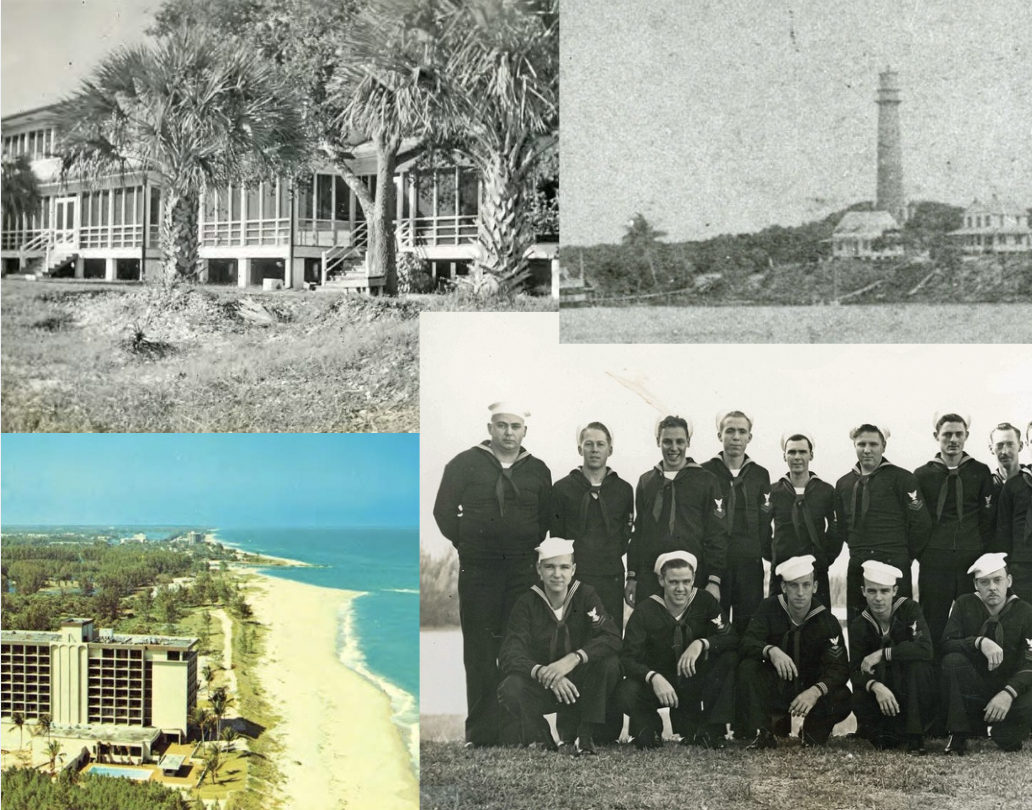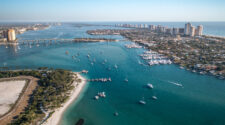A Little About the Jupiter Lighthouse
Photos Courtesy of Loxahatchee River Historical Society
Just like the Golden Gate Bridge needs to maintain its rusty pallor with frequent coats of paint, the Jupiter Lighthouse is also no stranger to getting primed and painted. But, surprisingly enough, the Lighthouse wasn’t always the rich red that we’re familiar with. Until around 1905, the Lighthouse was unpainted brick, then painted two different shades of red before we landed on the current iteration: Black, white, and now, red all over.
In addition to that colorful curveball, there are nearly two centuries of fun facts and history wrapped up in the Jupiter Inlet Lighthouse & Museum (and even more on Jupiter itself). Allow us to shine a spotlight on more of its history and significance in shaping our little beach town — if only to help with your next trivia night.
This history is carefully preserved by the Loxahatchee River Historical Society (LRHS), which has functioned as the modern keeper of the Lighthouse & Museum since 1994. From the Lighthouse’s beginning to 1987 (when the Lighthouse was automated), more than 200 civilian and military keepers and caretakers have faithfully served the Lighthouse. Now, the LRHS has taken up the mantle of ensuring the upkeep and success of the Lighthouse and its extensive education programs. The Lighthouse is also still an active aid for maritime navigators, and the optics are owned by the U.S. Coast Guard.
“As custodians of the Jupiter Inlet Lighthouse & Museum and managing partners of the Jupiter Inlet Lighthouse Outstanding Natural Area (ONA), the LRHS prioritizes the preservation of the region’s rich heritage. Through meticulous collection, conservation, and interpretation efforts spanning more than 8,000 years of documented history, we ensure the enduring legacy of the Loxahatchee River. Collaboration with partner organizations and governmental bodies reinforces our commitment to maintaining the Lighthouse as a national treasure,” said Katrina Heller, the executive director of Jupiter Inlet Lighthouse & Museum.
Collaborations include working with entities like Visit Florida, Discover the Palm Beaches, local cultural councils and chambers of commerce, as well as with the Bureau of Land Management, River Center, and Florida Public Archaeology Network to create events, educational initiatives and exhibits.
Your History Lesson
But let’s start at the beginning. Congress appropriated $35,000 for the Lighthouse in 1853 after deciding Jupiter was in need of a navigation aid, and construction was finished in 1860. Delays were caused by weather complications in the Inlet and because of the outbreak of the Third Seminole War, but the majority of the work was completed in just five months (January to July of 1860).
This initial delay in construction was not the last time the Lighthouse would find itself subject to the wiles of weather, war and, most recently, sickness.
During the Second and Third Seminole Wars, U.S. Army soldiers who occupied Fort Jupiter suffered from what they called “Jupiter Fever” — which we believe is what New Yorkers flocking here in 2024 also suffer from. (Too soon?) “Jupiter Fever” was likely a form of malaria, but diseases transferred by mosquitos were not yet understood. The American Civil War brought yellow fever scares (another mosquito-borne disease) in neighboring areas, but Jupiter pioneers suffered no outbreaks. They still set up quarantine stations at all points of entrance, which included the Inlet in which the Lighthouse had just been built. Those of us contemporary Jupiter residents may recall a parallel with the Lighthouse closing during the COVID-19 outbreak and opening a couple of weeks later with limited hours and access.
Like sickness, war has also had a part in the Lighthouse’s history. The First-order Fresnel lens was temporarily extinguished by Confederate sympathizers who chased off the headkeeper — after just a few years of light — during the onset of the Civil War, and it remained extinguished throughout the war until it was relit in June 1866. Over the course of the Civil War, the Lighthouse was used by both Union and Confederate soldiers as an observation platform. In 1939, the U.S. Coast Guard joined the civilian lighthouse service in the Inlet. They had assumed operation of all U.S. lighthouses. One year later, a Navy radio station, Station J, was set up in the Jupiter Lighthouse to utilize top-secret high-frequency radio technology that would intercept German U-boat transmissions and prevent Allied merchant ships off the coast of Florida from being sunk. These ships, mainly leaving from Texas and New Orleans, carried war supplies and fuel to the front. Jupiter only had about 800 residents at the time, and some Navy servicemen who were stationed at the site returned to start families in Jupiter (Now that’s a real local). Later, the grounds would also briefly serve the Air Force as the Jupiter Auxiliary Air Force Base, the first missile tracking station south of Cape Canaveral, before being placed back in the hands of the Coast Guard.
Learning at the Lighthouse
Now, the Lighthouse and its 120 acres of surrounding land function as a beacon of education and community, owned by the Bureau of Land Management (BLM) since 2019.
Visitors can do so much more than just climb the 105 steps to the top of the Lighthouse. They can stand inside the building that housed the top-secret Station J (closed with the bridge construction), hike the surrounding acres, take a yoga class on the deck that marks the location of the original keepers’ house, and more. Katrina said, “Our diverse array of educational programs at the Jupiter Inlet Lighthouse & Museum serves as a cornerstone for community enrichment. From guided tours exploring Native American history and archaeology to immersive experiences like the Day in the Life of a Lighthouse Keeper tour, we offer engaging learning opportunities for all ages. Specialized programs such as Sensory Sensitive Mornings cater to diverse needs, ensuring inclusivity and accessibility. By delving into our past, we inspire and empower future generations to cherish and preserve our heritage.”
Admission to these programs helps cover the costs incurred during the Lighthouse’s routine maintenance. Once or twice a year, the Lighthouse requires essential upkeep like lens cleaning, structural inspections, and corrosion prevention measures. Repainting only occurs every 10 years, with it last taking place in 2019, to maintain that vibrant red that is the metaphorical cherry on our skyline.
Of course, the U.S. 1 Bridge construction project has left the Lighthouse cut off from one of its main thoroughfares for visitors. “The closure of the U.S. 1 Bridge has significantly altered the daily experience at the Lighthouse. While an alternative route via A1A exists, the Bridge closure has disrupted the convenience for our visitors, who previously enjoyed easier access to the Lighthouse grounds. Moreover, the closure necessitated the temporary shutdown of our museum. To safeguard valuable artifacts from the effects of construction, we undertook the careful relocation of these items to a secure location. We have also closed our gift shop and relocated to trailers adjacent to our main building for the safety of our volunteers, guests, and staff,” shared Katrina.
Through closures, shifting shades of red, and multiple wars, the Jupiter Lighthouse continues to be a symbolic and literal guiding force in Jupiter. In fact, our town would probably look a lot different if Jupiter Inlet wasn’t among the chosen sites for a new lighthouse.
If you’re still reading, you might as well invest some more time and visit the Lighthouse.
Lighthouse Park, 500 Captain Armour’s Way, Jupiter
jupiterlighthouse.org
@jupiter_lighthouse















